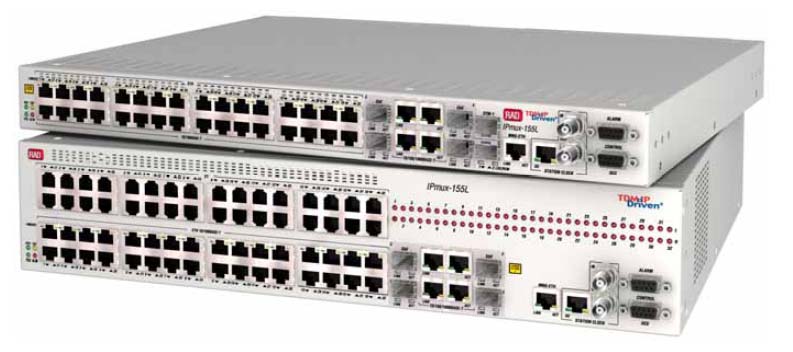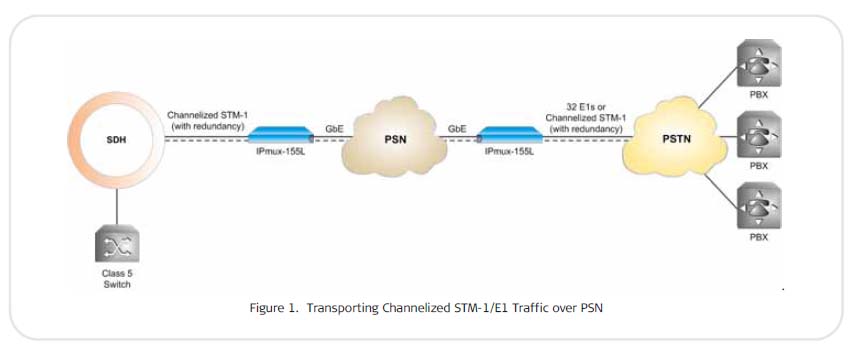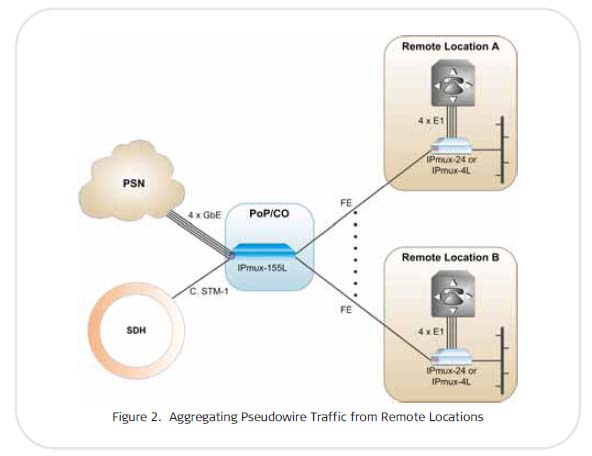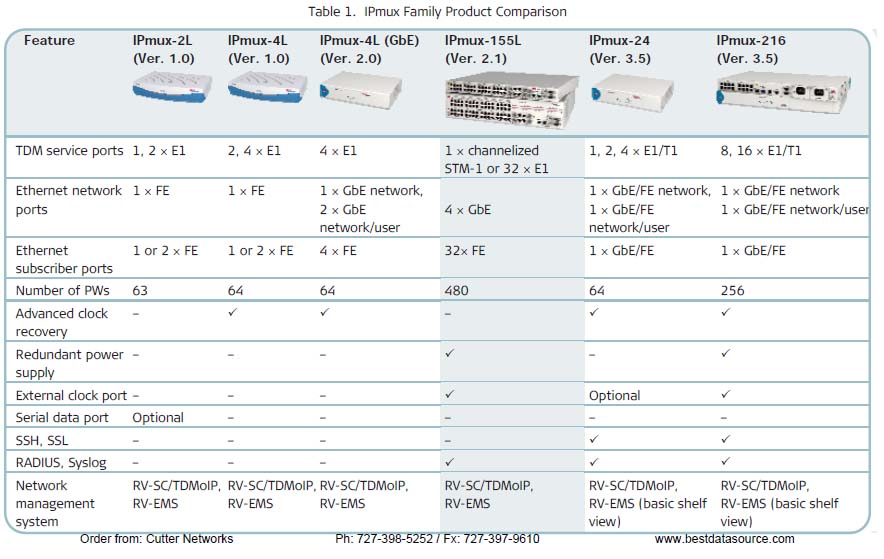




IPmux-155L Hub-Site Pseudowire Access Gateway from RAD
IPmux®-155L is a pseudowire gateway that transports TDM traffic (originating from
legacy circuit-switched networks) over packet-switched networks (PSNs). This is achieved by converting TDM data streams
coming from the TDM ports into packets transported over the PSN.
The RAD IPmux-155L includes the following ports:
1 + 1 redundant STM-1 or 32 E1 ports
Four Gigabit Ethernet ports with traffic protection
32 fiber optic or electrical Fast Ethernet user ports.

The RAD IPmux-155L is used for:
Aggregating traffic from remote pseudowire devices, such as IPmux-24 or IPmux-2L, at a small PoP or CO,
while eliminating the need for an additional Ethernet switch.
Transporting STM-1 or E1 traffic over PSN, saving TDM leased line costs.
PSEUDOWIRE FUNCTIONALITY OF THE IPMUX-155L
The ASIC-based architecture provides a robust and high-performance pseudowire solution with minimal processing delay.
The RAD IPmux-155L employs SAToP, CESoPSN and TDMoIP pseudowire encapsulation methods.
Proper balance between PSN throughput
and delay is achieved via configurable packet size. A jitter buffer compensates for packet
delay variation (jitter) of up to 200 msec in the network.
IPMUX-155L PSEUDOWIRE TIMING
End-to-end synchronization between circuits is maintained by the adaptive clock recovery mechanism.
Clock recovery conforms to G.823
interface using G.8261-defined scenarios. The system clock uses master and fallback
timing sources for clock redundancy. IPmux-155L also provides system clock input and output via an external clock port.
SDH INTERFACE OF THE RAD IPMUX-155L
The SDH interface provides direct access to the Synchronous Digital Hierarchy (SDH) transmission cores at the STM-1
level (155.520 Mbps).
SDH mapping mechanism collects payload from 63 internal E1 streams and directs it
towards STM-1 link.
The physical STM-1 ports can be ordered with field-replaceable SFP transceivers with optical interfaces, for meeting a wide
range of operational requirements.
1+1 APS line redundancy ensures rapid restoration of service in case of STM-1 line
failure.
AU4/TU12 pointer operation complies with G.783, G.707 requirements. Trace messages with 16-byte sequences (J1 and
J2 bytes) are generated and monitored.
E1 INTERFACE
32 external E1 interfaces provide connectivity to any standard E1 devices.
E1 interfaces feature:
Integral LTU for long haul applications
G.703 unframed and G.704 framed modes
CAS and CRC-4 bit generation (E1).

IPMUX-155L ETHERNET INTERFACE
IPmux-155L features the following PSN ports:
Four Gigabit Ethernet ports with SFP-UTP combo connectors
32 Fast Ethernet ports with fiber optic SFP or UTP connectors.
The GbE interface operation complies with IEEE 802.3, 802.1Q and 802.1p requirements.
Link aggregation is performed as per 802.3ad (with or without LACP). This enables operators to use up to four
Ethernet links as a single virtual interface, sharing traffic load and providing link
resiliency.
G.8032 ETHERNET RING
The RAD IPmux-155L employs a G.8032 Layer-2 Ethernet ring mechanism to protect against link and node failures.
ETHERNET OAM
IPmux-155L provides OAM to monitor and troubleshoot the Ethernet network and quickly detect failures. The OAM
mechanism operates according to IEEE 802.3ah requirements for fault indication and loopback activation response.
ETHERNET CAPABILITIES
The RAD IPmux-155L includes an internal bridge, operating in VLAN-aware and VLAN-unaware modes.
VLAN stacking can be used for traffic separation between different users or services, by defining a service provider
VLAN ID per customer or service. When VLAN stacking is used, a service provider VLAN tag is added to the user traffic and
removed from network traffic. Both service provider VLAN ID and service provider VLAN priority can be defined.
User traffic can be queued and prioritized according to VLAN priority and ToS/Diffserv.
Ingress and egress rate can be limited per user and network ports. Policing and classification of the traffic
flows are performed between any ingress and any egress Ethernet port of the device. IPmux-155L monitors traffic with
specified flow parameters, allocates bandwidth, forwards traffic to different queues according to classification
parameters etc.

IPmux-155L SYSTEM REDUNDANCY
System architecture provides redundancy
at different levels:
GbE interface with 802.3ad-based link aggregation
STM-1 1+1 line redundancy with less than 50 ms restoration of service in case of link faults
Redundant power supply units and fans.
MiRICi-E3T3 SUPPORT
When equipped with a removable MiRICi-E3T3 module (ver. 2.5), a fiber FE port
can operate as a T3 port, forwarding
LAN packets to TDM-based WAN.
MANAGEMENT CAPABILITIES
The RAD IPmux-155L can be managed using different ports and applications:
Local out-of-band management via a terminal connected to the RS-232 port
Remote out-of-band management via the dedicated 10/100BaseT port
Remote inband management via the GbE or FE interface. Remote management is performed using Telnet
or RADview, RADs SNMP-based EMS. Software is downloaded via the local terminal, using XMODEM/YMODEM, or
remotely, using TFTP/FTP. The Syslog protocol is used by IPmux-155L to generate and transport event
notification messages over IP networks to the central Syslog server. The Syslog operation is compliant with the RFC 3164
requirements.
OAM AND STATISTICS
Comprehensive monitoring and diagnostic capabilities include port status indication
and statistic counters for Gigabit Ethernet and STM-1 interfaces.
RADs TDM PW OAM mechanism verifiesconnectivity and prevents pseudowire configuration mismatch.
ALARM REPORTING OF THE FCD-155L
The RAD FCD-155L includes a dry-contact connector for reporting alarms to external
equipment. The connector also has an external alarm input for monitoring external sensors.
TIMING
IPmux-155L features a flexible clock mechanism using external and internal timing signals coming from:
SDH clock (8 kHz)
2.048 MHz clock recovered from a PW flow, E1 line or GbE port (Sync-E)
External station clock source via station clock port, providing out-of-band synchronization.
DIAGNOSTICS
For diagnostic purposes, IPmux-155L maintains a cyclic event log file that stores
up to 2048 time-stamped events and a real-time current alarm list. To verify the TDM link integrity,
IPmux-155L provides local or remote loopbacks on the VC-4 and E1 interfaces. User-activated BER
tests can be generated to analyze E1 streams. An internal built-in test (BIT) performed
after power-up checks the internal circuitry of the unit. The results of the test
are visible via the local terminal.

IPmux-155L product data sheet (pdf)